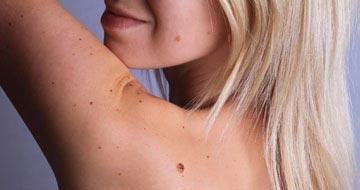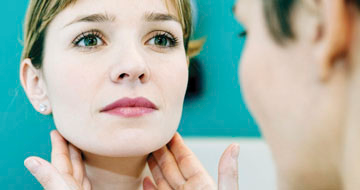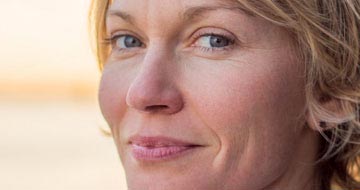
Does too much sun exposure cause melanoma?
Summer might be over, but when it comes to melanoma – a type of skin cancer where moles are the most obvious sign – recent studies have shown that exposure to sunlight is not the greatest risk factor.
We talked with Dr Veronique Bataille, consultant dermatologist at our clinic, about what her extensive research and experience in dermatology has taught her about melanoma.
If sunlight is not the greatest risk factor for melanoma, what is?
With melanoma, the risk factors are so different than other types of skin cancer. You always hear about sunshine being the most significant risk - too many sunbeds, too many beach holidays, etc. But research shows that there are many more factors that pose greater risks to patients, that have nothing to do with sunlight.
We’re now learning more about the significance of genetics. By studying in detail what makes someone more at risk to melanoma – such as having a high number of moles, especially large moles – it becomes apparent that it’s quite genetic. If you look at identical twins their moles display 60% similarity. This noticeable similarity is not present in non identical twins.
So, why do doctors still advise us to stay out of the sun?
Sunlight is the only environmental factor you can act upon by reducing it, so the risk has been exaggerated. Many risk factors for melanoma have nothing to do with sunlight.
If you want to avoid ageing prematurely, or to minimise wrinkles, sunspots or less dangerous types of skin cancer, then it’s sensible to limit the time you spend in the sun. But I tend to concentrate on many other, less understood factors when I see my patients.
Do people with melanoma look very sun damaged?
No. It’s often quite the contrary. Because of the common belief that melanoma is caused by excessive sunlight, one would expect these people to be very sun damaged, and have very thin, wrinkled skin on exposed parts of the body. But it’s the other way around. They have quite good skin for their age compared to their peers with fewer wrinkles and sun damage that you would expect from a cancer that’s believed to be caused by too much sun.
Looking at the genetics of ageing in general, we realised that in fact the genes that increase your susceptibility to melanoma very interestingly are also those which protect you from early ageing. These genes are associated with longevity, stronger bones and stronger muscles. So having risk factors for melanoma may have a positive impact – as long as you remain vigilant and keep an eye on any moles, your risk of dangerous melanoma in a lifetime is still quite low.
Do moles appear in different places on males and females?
In terms of position on the body, females do tend to get the melanoma on the legs, whereas males get the melanoma on the torso. It’s obviously not black and white. But overall, this is the case, and it’s due to genetic differences between males and females earlier on in life.
So we started to really look at what genes are affected by. This type of research is important as we still don’t understand why females survive their melanoma better than males. There are probably important genes on the X chromosomes, which play a role in this, as women carry two X chromosomes, while males only have one.
So family history plays a big role in melanoma?
Indeed. If you have one or two family members with melanoma, then this will increase your risk and you should have a skin check up. If you have a strong family history of multiple types of cancer and you have a lot of moles then your risk increases, too and you should be checked as well.
If a patient comes in for a mole check, what are the first things you assess?
The first thing a dermatologist does is look at your skin colour and assess whether you are fair. Then we ask questions about family history of all cancers – not only melanoma. We examine all the moles on the whole body to assess how many moles – especially flat moles – there are. Their size is important too. A patient’s past sun exposure is not the most important thing in their history for me, as most of us have had a few incidents of sunburn in our life and a fairly average number of weeks abroad every year. Only those who have had long periods in their life in countries with strong sun exposure may be considered relevant.
If there has been a melanoma diagnosis in a close member of the family, then the patient will be followed up yearly for life – similarly if there are multiple cancers in a family and the skin is covered with many moles. We cannot follow everybody so we make a decision on long term follow up according to what we see, and the family history. We may offer mole mapping, when there are many moles and they are quite large. Usually we offer this once a year for those at high risk.
I’m amazed at the number of patients who come to my clinic and say that they have no idea of their family history of cancers. They might in some cases be able to tell me that their family members had cancer, but not what type. So my first piece of advice to patients is to be more curious about their family history. Know it in detail, because it allows us to determine whether a patient is at high risk or melanoma or not. Without any family history it’s quite hard for us to assess this risk properly.
At what age would people come to see you?
Melanoma is extremely rare in children so we do not recommend screening below the age that puberty begins in families at high risk. The average age for melanoma in the UK is 55. It is a cancer unfortunately (unlike the more common cancers like breast, colon or lung cancer), which affects younger people on average so everybody needs to be aware of this and be vigilant regarding changes on their skin.
Is there any harm in the current, common advise to stay out of the sun?
What’s really sad in the melanoma world is that once a patient has had a melanoma, they tend to be scared of going in the sun. I believe our public health campaigns have made the sun a number one enemy. So some people might avoid sun too much, change their lifestyle dramatically, when, in the end these radical changes may not have much impact on how their body fights the melanoma.
In fact, there have been studies showing that after a diagnosis of melanoma, patients have very low levels of vitamin D because they’re fearful of sun exposure. Low vitamin D levels can affect many aspects of our health and we have to be careful not to scare our patients, as they need to enjoy life – making them very anxious should be avoided.
When you think about it, we’ve always had that big yellow sun in the sky, and human beings have evolved with it. Within two generations the advice has been, “Don’t go in the sun, wear sunscreen everyday.” Most cosmetics have SPF around 15 to 30 now and women now wear them all year round in the UK. And obviously that’s not going to be right. Sometimes, there’s a lot of advice that’s passed off as ‘science’ but it’s not unfortunately backed up and taken to the extreme. People are unaware that one of the reasons we have more melanomas is because we screen more and these very early fairly stable melanomas may never have harmed patients. That might be a difficult concept to grasp but it is the same for many cancers like breast and prostate screening. So in cancer when you hunt you find, but you should be aware of the consequences of lots of screening and not attribute all to too much sun.
And what are the survival rates for patients with melanoma?
In this country, after having a melanoma removed (which requires stitches) most patients have no problems after that and do very well.
What’s fascinating is this: Australia has lots of campaigns around educating the public about the dangers of sunlight and have screening clinics on every high street. And yet their mortality rate for melanoma is very similar to the UK. This does not mean that Australia should not continue their efforts, as the rates of all types of skin cancer are very high but it is important to question data.
What about aggressive melanoma?
What we realise is that there is a group of nasty melanoma with a similar frequency all over the world which typically grows quickly and appears quite fast. That means we have to be as vigilant as possible about changes on our skin. These are the exceptions, luckily, and many melanomas grow slowly and are less dangerous.
However, my advice to anyone would be to not hang around if you see changes in one of your moles. Of course, if you go to countries where there is a very poor provision of dermatologists and lack of education, then the outcome is not as good for patients. But it’s not to do with too much sun exposure. It’s about lack of resources to diagnose, treat and manage patients who may be at risk.
We have to do a lot more work to understand what increases our risk of melanoma, aside from fair skin, lots of moles and a family history of cancer. What is a new, exciting area is skin and gut microbiome (the bacteria living on our skin and in our gut) which are likely to affect our risk. So, watch this space!











